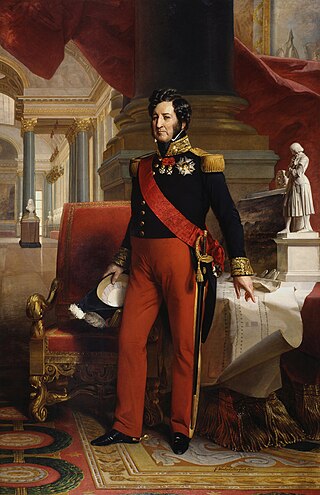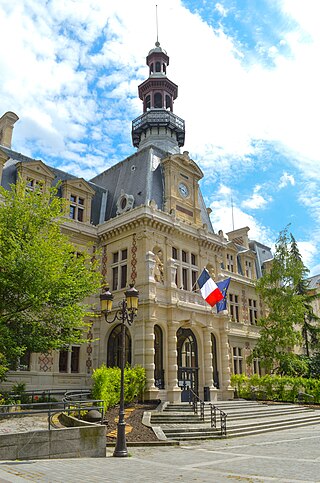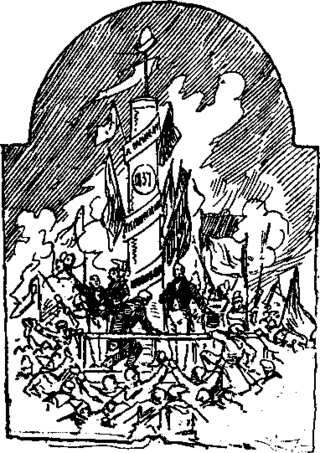
The Bastille was a fortress in Paris, known as the Bastille Saint-Antoine. It played an important role in the internal conflicts of France and for most of its history was used as a state prison by the kings of France. It was stormed by a crowd on 14 July 1789, in the French Revolution, becoming an important symbol for the French Republican movement. It was later demolished and replaced by the Place de la Bastille.

Louis Philippe I, nicknamed the Citizen King, was King of the French from 1830 to 1848, and the penultimate monarch of France. He abdicated from his throne during the French Revolution of 1848, which led to the foundation of the French Second Republic. As Louis Philippe, Duke of Chartres, he distinguished himself commanding troops during the French Revolutionary Wars and was promoted to lieutenant general by the age of nineteen, but he broke with the Republic over its decision to execute King Louis XVI. He fled to Switzerland in 1793 after being connected with a plot to restore France's monarchy. His father Louis Philippe II, Duke of Orléans, fell under suspicion and was executed during the Reign of Terror.

The Place de la Concorde is a public square in Paris, France. Measuring 7.6 ha in area, it is the largest square in the French capital. It is located in the city's eighth arrondissement, at the eastern end of the Champs-Élysées.

The Place de la Bastille is a square in Paris where the Bastille prison once stood, until the storming of the Bastille and its subsequent physical destruction between 14 July 1789 and 14 July 1790 during the French Revolution. No vestige of the prison remains.

The 4th arrondissement of Paris is one of the twenty arrondissements of the capital city of France. In spoken French, this arrondissement is referred to as quatrième. Along with the 1st, 2nd and 3rd arrondissements, it is in the first sector of Paris, which maintains a single local government rather than four separate ones.

The 12th arrondissement of Paris is one of the 20 arrondissements of the capital city of France. Situated on the right bank of the River Seine, it is the easternmost arrondissement of Paris, as well as the largest by area. In 2019, it had a population of 139,297.

The French Revolution of 1830, also known as the July Revolution, Second French Revolution, or Trois Glorieuses, was a second French Revolution after the first in 1789. It led to the overthrow of King Charles X, the French Bourbon monarch, and the ascent of his cousin Louis Philippe, Duke of Orléans. After 18 precarious years on the throne, Louis-Philippe was overthrown in the French Revolution of 1848.
The year 1840 in architecture involved some significant architectural events and new buildings.

The Musée Carnavalet in Paris is dedicated to the history of the city. The museum occupies two neighboring mansions: the Hôtel Carnavalet and the former Hôtel Le Peletier de Saint Fargeau. On the advice of Baron Haussmann, the civil servant who transformed Paris in the latter half of the 19th century, the Hôtel Carnavalet was purchased by the Municipal Council of Paris in 1866; it was opened to the public in 1880. By the latter part of the 20th century, the museum was full to capacity. The Hôtel Le Peletier de Saint Fargeau was annexed to the Carnavalet and opened to the public in 1989.

Jean-Antoine Alavoine was a French architect best known for his column in the Place de la Bastille, Paris (1831–1840), the July Column to memorialize those fallen in the Revolution of 1830. The column, consciously larger-scaled than the column in the Place Vendôme, has a capital freely based on the Corinthian order, with exaggerated corner volutes flanking putti holding swags, a complicated and somewhat incoherent design that found no imitators.
Events from the year 1840 in art.

The Bastille Day military parade, also known as the 14 July military parade, translation of the French name of Défilé militaire du 14 juillet, is a French military parade that has been held on the morning of Bastille Day, 14 July, each year in Paris since 1880, almost without exception. The parade passes down the Avenue des Champs-Élysées from Place Charles de Gaulle, centred around the Arc de Triomphe, to the Place de la Concorde, where the President stands, along with members of the Government, figures from the legislative branch, the Mayor of Paris, as well as foreign ambassadors to France.

The National Congress was a temporary legislative assembly in Belgium, convened in 1830 in the aftermath of the Belgian Revolution. Its purpose was to devise a national constitution for the new state, whose independence had been proclaimed on 4 October 1830 by the self-declared Provisional Government.

The Colonne de la liberté was a symbol of the Patriote movement erected in Saint-Charles, Lower Canada, on October 23, 1837. Its name is identical to the column that marked the history of the French Revolution. In 1982, because of the Comité des Patriotes and the Quebec Ministry of Culture, a replica was raised on its presumed original location and still stands today.

Grande symphonie funèbre et triomphale, Op. 15, is the fourth and last symphony by the French composer Hector Berlioz, first performed on 28 July 1840 in Paris. It is one of the earliest examples of a symphony composed for military band.

The June Rebellion, or the Paris Uprising of 1832, was an anti-monarchist insurrection of Parisian republicans on 5 and 6 June 1832.

The French Revolution of 1848, also known as the February Revolution, was a period of civil unrest in France, in February 1848, that led to the collapse of the July Monarchy and the foundation of the French Second Republic. It sparked the wave of revolutions of 1848.

The Musée de la Révolution française is a departmental museum in the French town of Vizille, 15 kilometres (9.3 mi) south of Grenoble on the Route Napoléon. It is the only museum in the world dedicated to the French Revolution.

The Elephant of the Bastille was a monument in Paris which existed between 1813 and 1846. Originally conceived in 1808 by Napoleon I, the colossal statue was intended to be created out of bronze and placed in the Place de la Bastille, but only a plaster full-scale model was built. At 24 m (78 ft) in height, the model itself became a recognisable construction and was immortalised by Victor Hugo in his novel Les Misérables (1862) in which it is used as a shelter by the street urchin Gavroche. It was built at the site of the Bastille and, although part of the original construction remains, the elephant itself was replaced a few years later by the July Column (1835–40) constructed on the same spot.
The style of architecture and design under King Louis Philippe I (1830–1848) was a more eclectic development of French neoclassicism, incorporating elements of neo-Gothic and other styles. It was the first French decorative style imposed not by royalty, but by the tastes of the growing French upper class. In painting, neoclassicism and romanticism contended to become the dominant style. In literature and music, France had a golden age, as the home of Frédéric Chopin, Franz Liszt, Victor Hugo, Honoré de Balzac, and other major poets and artists.



















